Supply Chain Industry Statistics By Market Value, Common KPIs, Trends, Outsourcing And Challenges

Updated · Jan 16, 2025


TABLE OF CONTENTS
Introduction
Supply Chain Industry Statistics: From supplying raw materials to businesses to delivering the final products to the customers, the supply chain industry is maintaining its importance all over the world. However, managing little by little with international borders is somewhat difficult which creates loopholes in the supply chain industry. The major problem faced today is a shortage of labor in the industry as well as unseen natural calamities and geopolitical and economic crises. However, with advanced technology, these Supply Chain Industry Statistics show that the industry can tackle such issues. Today, only half of the supply chain businesses have incorporated automation in their industry, and yet making profits better than ever.
Editor’s Choice
- Only 6% of companies report full visibility into their supply chains. Meanwhile, 69% of businesses face poor visibility, which increases costs and reduces efficiency during disruptions.
- A significant 63% of companies do not use technology to monitor their supply chain performance, though 81% recognize that analytics will significantly reduce costs and boost efficiency.
- Only 53% of supply chain leaders have adequate master data quality, which is crucial for effective management and planning.
- The sector is undergoing digital transformation, increasingly using AI, IoT, and blockchain to enhance visibility and efficiency.
- Approximately 48% of companies are under pressure to improve sustainability in their supply chains, focusing on initiatives like electrification and renewable energy.
- The global supply chain management market is projected to grow from USD 25.74 billion in 2022 to around USD 72.1 billion by 2032, expanding at a CAGR of 10.9%.
- A vast 93% of senior supply-chain executives aim to make their supply chains more flexible and resilient in response to disruptions like pandemics and geopolitical conflicts.
- According to a KPMG survey, 43% of businesses had limited or unclear visibility into their Tier 1 suppliers, while 28% reported good visibility into Tier 2 suppliers.
- About 83% of supply chain businesses are prioritizing improvements in customer experience as their top online business strategy.
- In 2024, distribution and logistics are projected to be the most outsourced process in the industry, accounting for 42%.
- By 2025, process standardization and cloud services are expected to majorly influence supply chains, affecting 43% and 39% of the industry, respectively.
- In 2023, around 50% of global companies identified cybersecurity related to supply chains as a significant upcoming challenge.
- Six out of ten businesses are planning to invest in digital technologies to enhance supply chain management, including data analysis.
- By 2035, it is estimated that 45% of supply chain businesses will be automated, incorporating technologies like automated planning systems, robots, driverless vehicles, and delivery drones.
- 90% of global product supplies are transported by waterways, underscoring the importance of maritime logistics in the supply chain industry.
General Supply Chain Industry Statistics
- Companies with optimized supply chains are 15% less likely to experience supply chain costs, and 3 times quicker cash earnings. The percentage of such companies is predicted at 79%.
- According to 24.7% of people working in supply chains for B2C eCommerce companies, the biggest challenge is the delivery cost.
- 57% of companies have poor control of supply chain management.
- For 63% of businesses, being faster, and accurate in order fulfillment is the top priority.
- Furthermore, as of 2023, 63% of companies are yet to introduce technology to monitor the supply chain.
- 73% of supply chains feel pressured to improvise and expand their delivery capacity.
- According to Supply Chain Industry Statistics, the KPMG supply chain survey states that, in the next 3 years, 6 out of 10 worldwide businesses are concerned about the impact of geopolitical disturbances on their supply chains.
- Furthermore, as of 2023, the number of cyber criminals that invade supply chains to steal or damage the product will increase significantly.
- In 2023, around 50% of global companies stated cyber security in terms of supply chains as their important challenge for the coming years.
- As of today, 6 out of 10 businesses are planning to invest in digital technology to improve their supply chain management including data analysis.
- As of 2023, the global supply chain management industry was valued at $21.95 billion and is projected to reach $30.91 billion by 2026.
- 83% of supply chain businesses are focusing on improving their customer experience in the supply chain, being the top priority in online business strategy.
- By the end of 2024, manufacturers in Asia will apply multi-shoring to avoid reduced disruption.
- Supply Chain Industry Statistics state that 90% of worldwide product supply is shipped by waterways.
- 40% of total shipments through containers in the shipping industry are using fuel alternatives such as methanol or liquefied natural gas.
- By 2035, it is estimated that 45% of supply chain businesses will be automated including automated planning systems, robots, driverless vehicles, and delivery drones.
- 60% of business professionals believe that their companies should take important steps to manage supply chain challenges.
- According to the KPMG report of a survey related to Supply Chain Industry Statistics 2023, 43% of businesses had no or were unclear about the visibility of their Tier 1 suppliers. On the other hand, 28% showed a good visibility in Tier 2 suppliers.
- As of 2023, 36% of supply chains were impacted because of labor shortages, however, 37% of professionals think this is a longer-term issue while 36% think it is a short-term issue.
- According to the KPMG Future of Supply Chain Survey, in 2023, 37% of companies replaced human resources with advanced robots or automation in warehouses.
- As of 2024, 1 out of 3 businesses is planning on sustainable sourcing of supply chain strategy.
- As of 2023, every week, 89% of supply chain professionals spent 6 or more hours on related work.
- Every year, around $1.5 trillion gets shipped in and out of ports in the United States of America.
- As of 2023, 13 million people were dependent on port jobs.
- 76% of trade in the United States and 90% of international trade includes maritime traffic.
- Companies can add $5 million of extra products if there is an extra inch of water depth in the sea.
- According to a report published by PWC 2023, 83% of business leaders in supply chain management less agree with technological investments fully delivering the expected results.
- As of 2023, it was estimated that 50% of large-scale companies around the world would start using AI, IoT, and advanced analytics in the supply chain.
- On the other hand, 63% of companies do not use any technology to measure their supply chain management operations.
- Supply Chain Industry Statistics By 2028, the supply chain management software market is expected to be valued at $44.8 billion at expected to grow at a CAGR of 15.4% between 2023 to 2028.
- 67% of supply chain professionals use spreadsheets to manage their operational data.
- By 2025, 56% of decision-making in transportation will be automated.
- Compared to average performers in the industry, 79% of companies with well-managed supply chains earn more revenue growth.
By Market Value
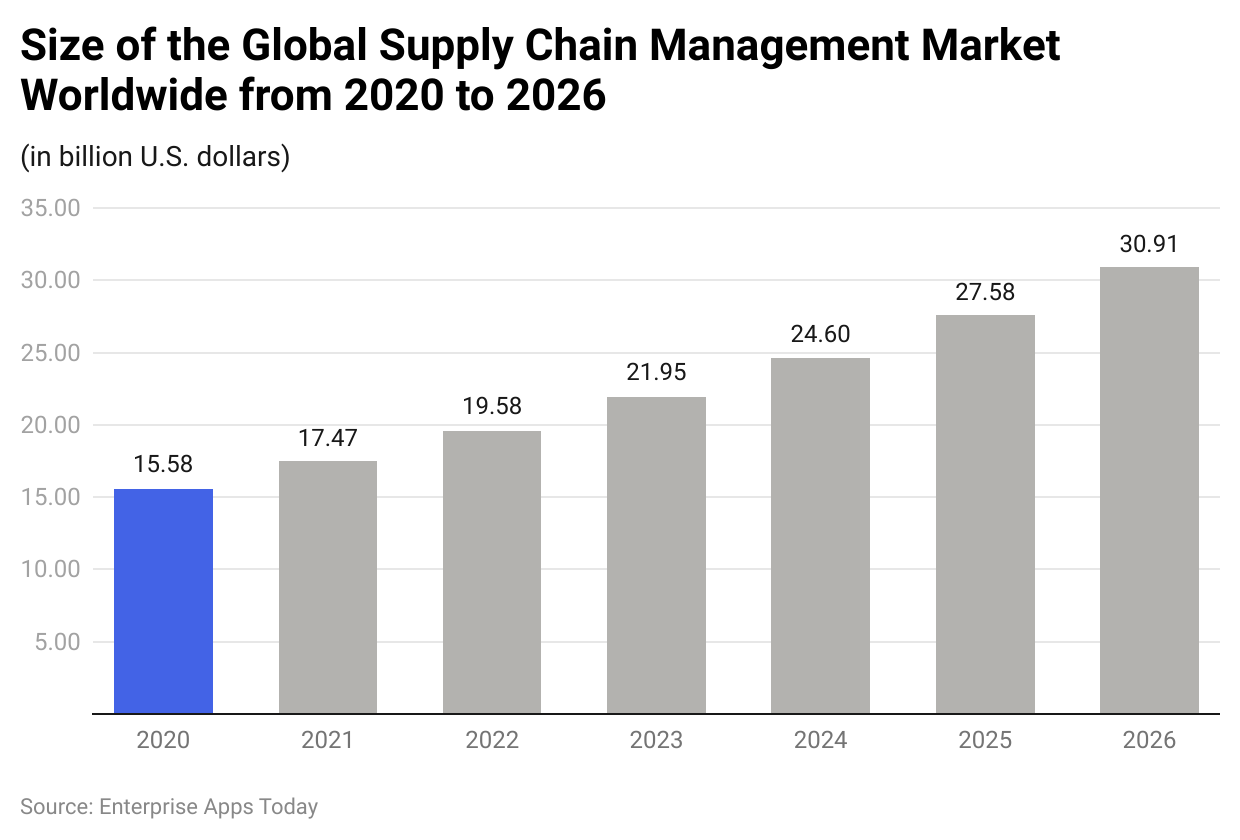 (Reference: statista.com)
(Reference: statista.com)
By 2026, global Supply Chain Industry Statistics estimated the market to be valued at $30.91 billion. Overall, since COVID-19, the market value will be increasing at a steady pace. As of 2024, it is valued at $24.6 billion.
By Common KPIs
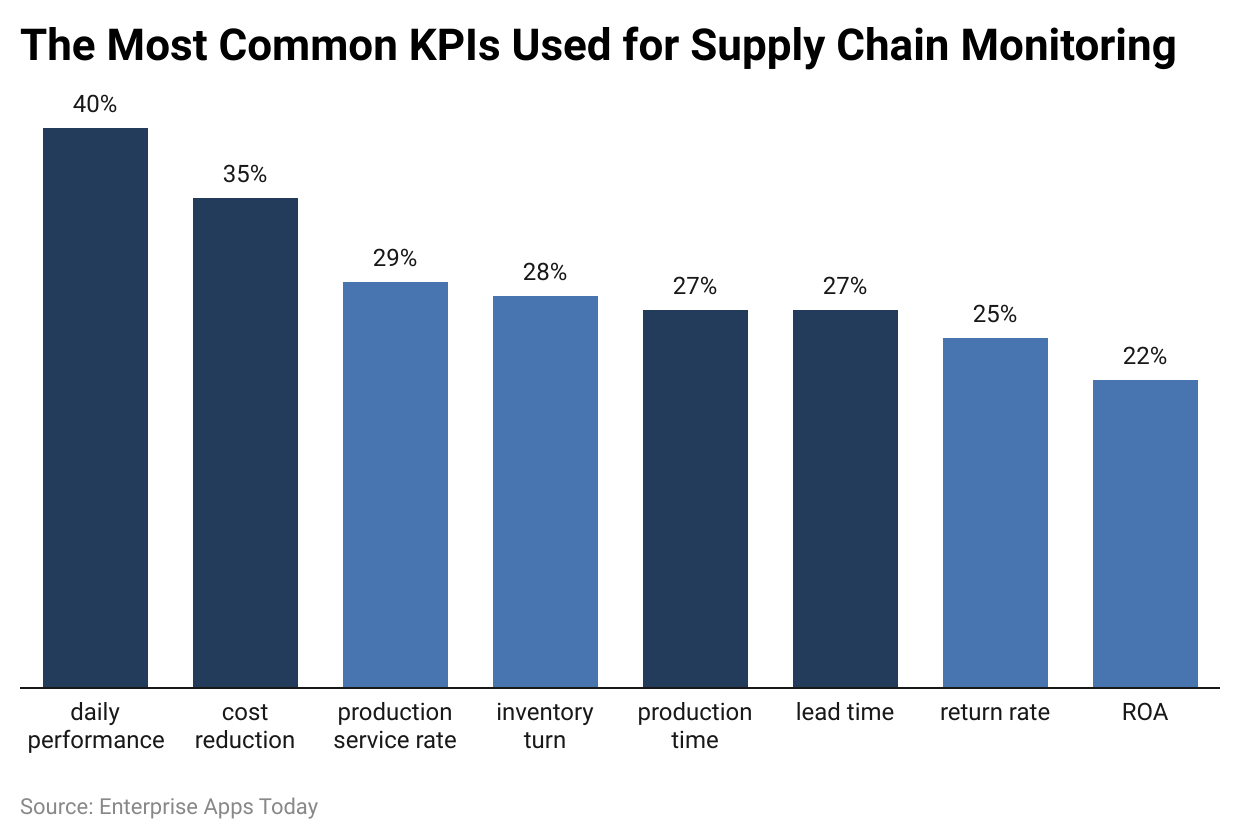 (Reference: financesonline.com)
(Reference: financesonline.com)
For the majority of businesses, the most common KPIs related to supply chain management are daily performance (40%), cost reduction (35%), and production service rate (29%). Other KPIs included in monitoring are return rate, lead time, production time, inventory turnover, and ROA.
By Trends
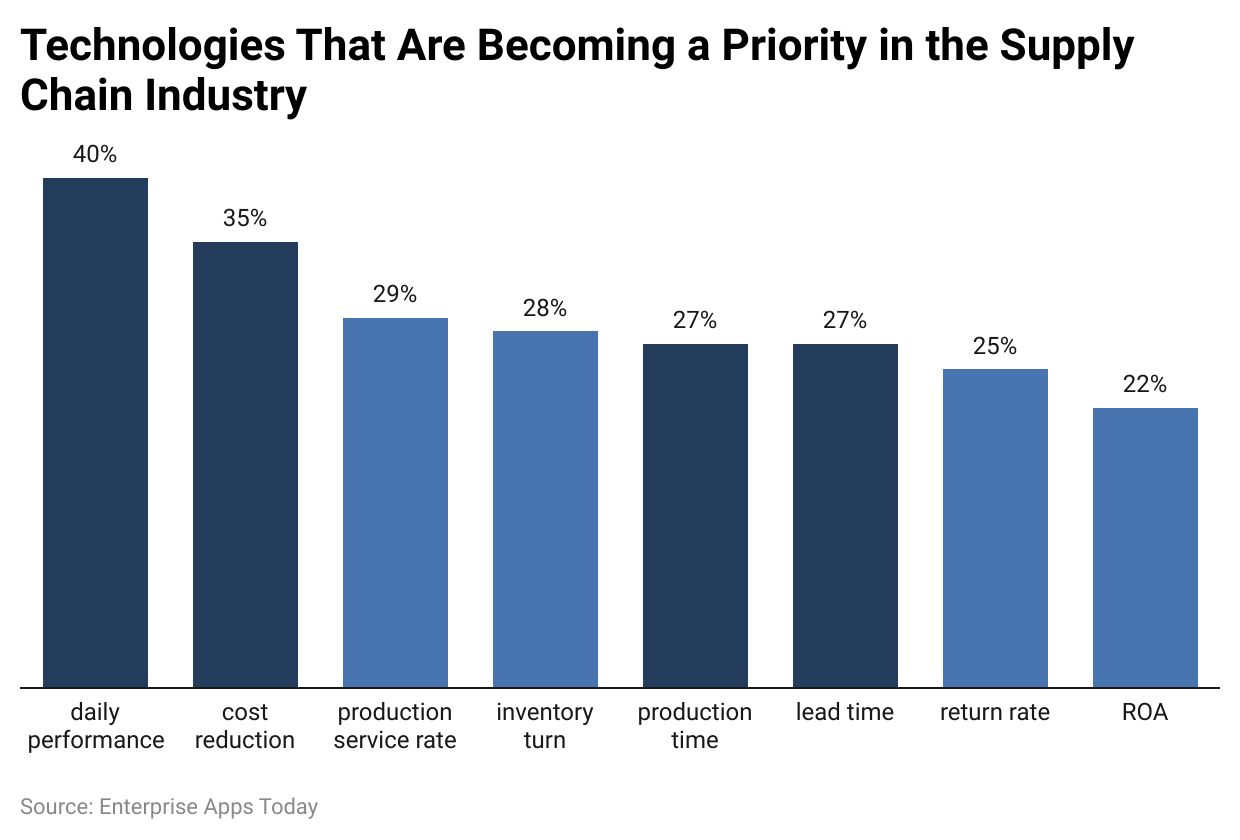 (Reference: financesonline.com)
(Reference: financesonline.com)
According to Supply Chain Industry Statistics 2024, the trending priority in the supply chain industry is data analysis resulting in 41%, followed by loT (39%) and Cloud computing (39%). In 2024, it is estimated other factors in managing the logistics are info security (31%), predictive analytics (29%), Apps (25%), 3D printing, Robotics (22%), Drones (20%) and mobile production units (19%).
By Outsourcing
 (Source: financesonline.com)
(Source: financesonline.com)
In 2024, it is projected that distribution and logistics will be the most outsourced process in
the supply chain industry by 42%. While manufacturing, finishing, and packaging will
outsourced at 37%,29%, and 23% respectively.
By Challenges
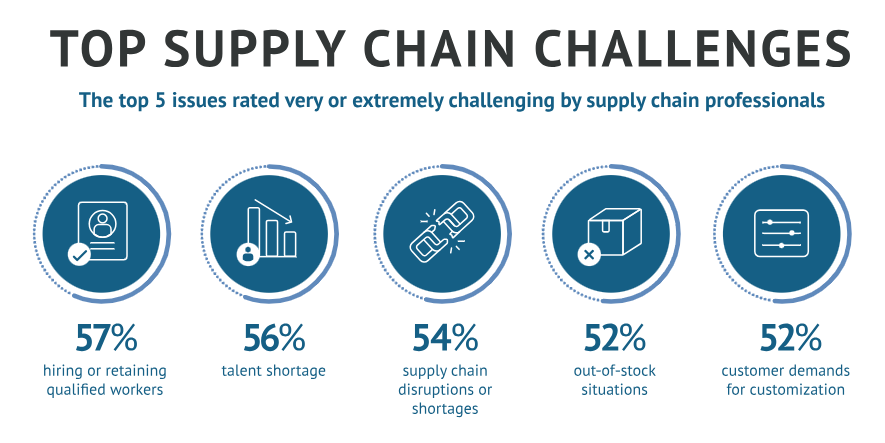 (Source: fitsmallbusiness.com)
(Source: fitsmallbusiness.com)
As of 2023, the top challenge in the supply chain management industry faced by professionals is hiring or retaining qualified workers resulting in 57%. Furthermore, more than half of the businesses say that there shortage in talent across the industry (56%). Other priority challenges marked by the professional were supply chain disruptions or shortages (54%) out-of-stock situations and customer demand for customization (52%).
By Actions Taken for Challenges
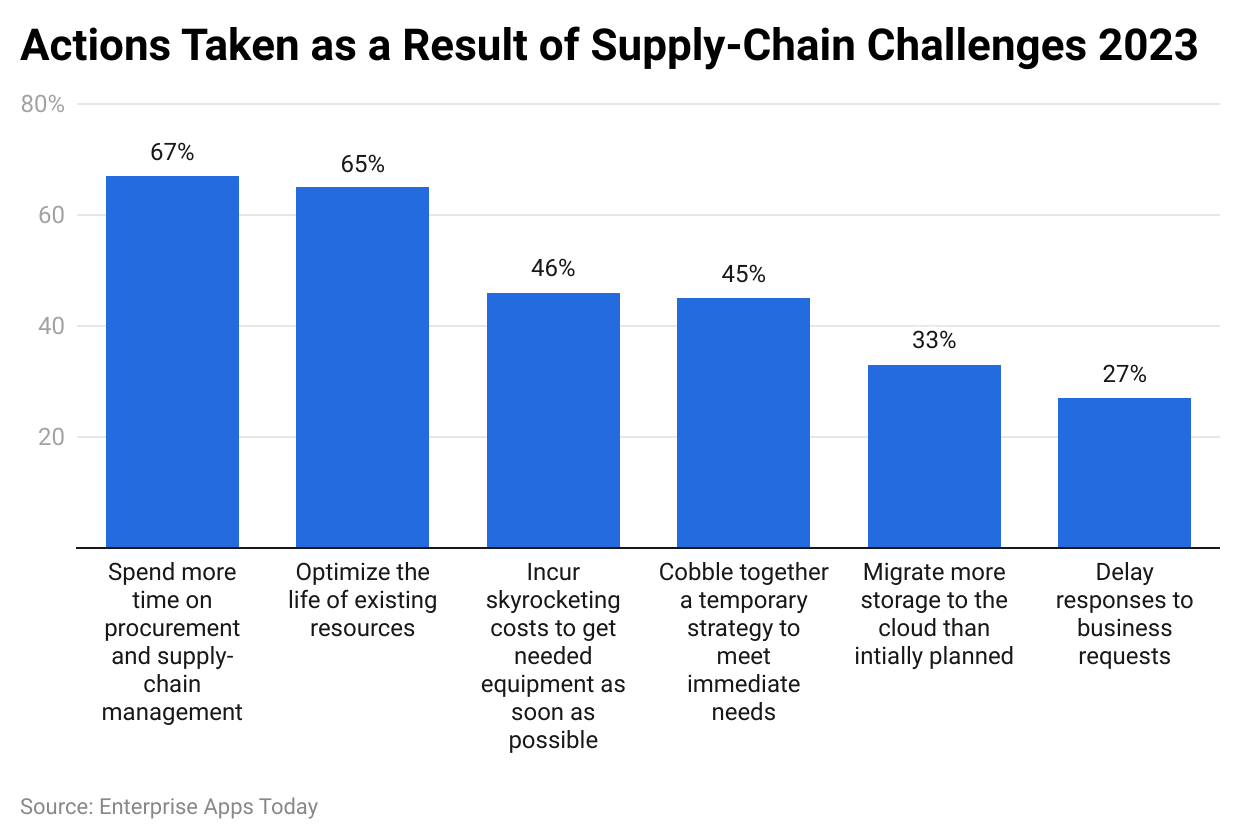 (Reference: statista.com)
(Reference: statista.com)
As of 2023, Supply Chain Statistics showed that 67% of people spent more time on procurement and supply chain management, while 65% optimized the life of existing resources. Respondents to a survey taken by Statista provided other actions taken as incorporating needed equipment as soon as possible (46%), creating a new strategy to meet immediate needs (45%), migrating data to the cloud in greater
percentage (33%), and delaying responses to business requests (27%.)
By Leading Impacting Projected Trends
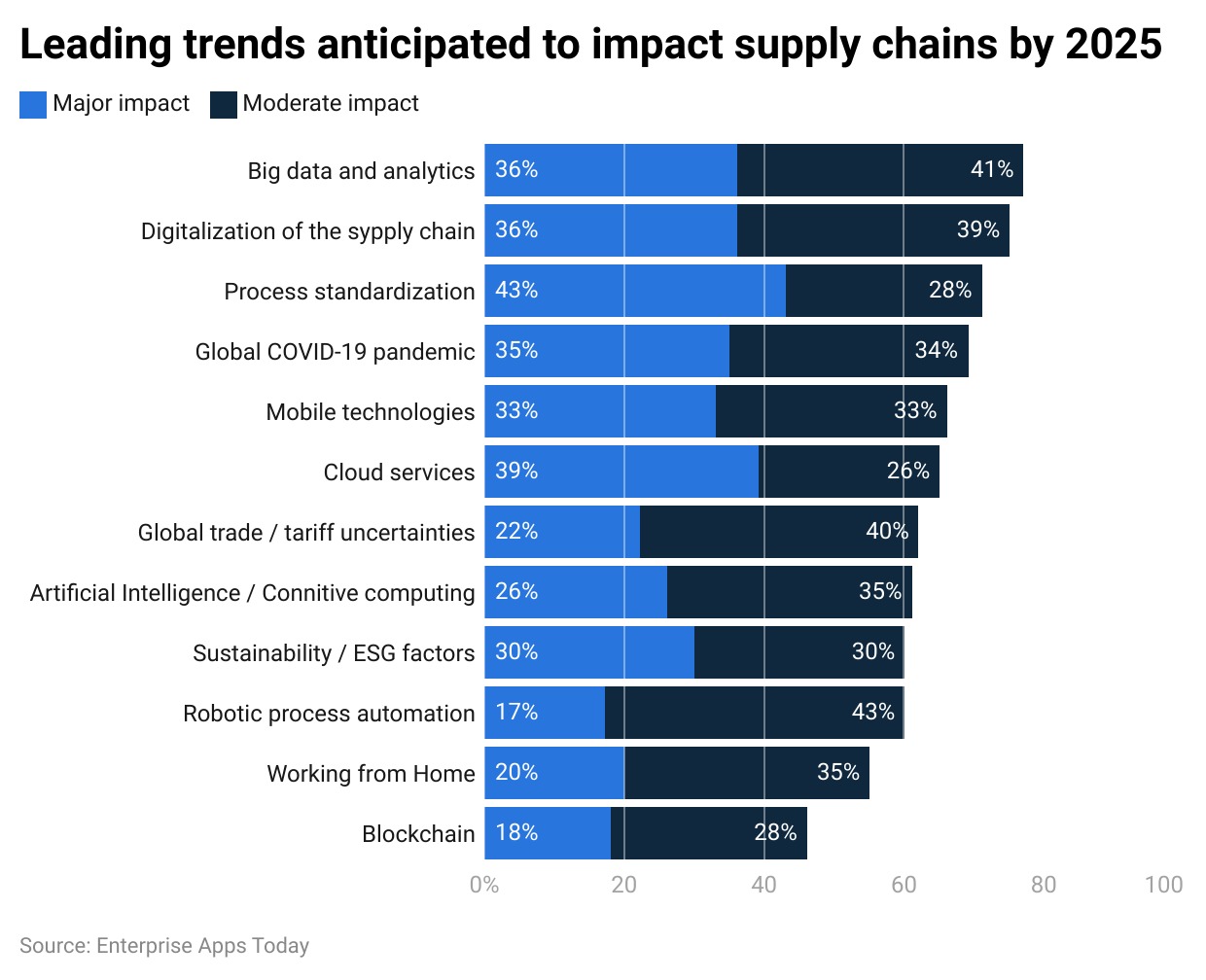 (Reference: statista.com)
(Reference: statista.com)
Supply Chain Industry Statistics 2024 projects that process standardization and cloud services will majorly impact the supply chains by 2025, resulting in 43% and 39% respectively. On the other hand, working from home and blockchains will experience the lowest moderate impact in similar industries with 35% and 28%. Furthermore, the lowest major impact is considered for robotic process automation resulting in 17%.
By Objectives of Investment in Technology
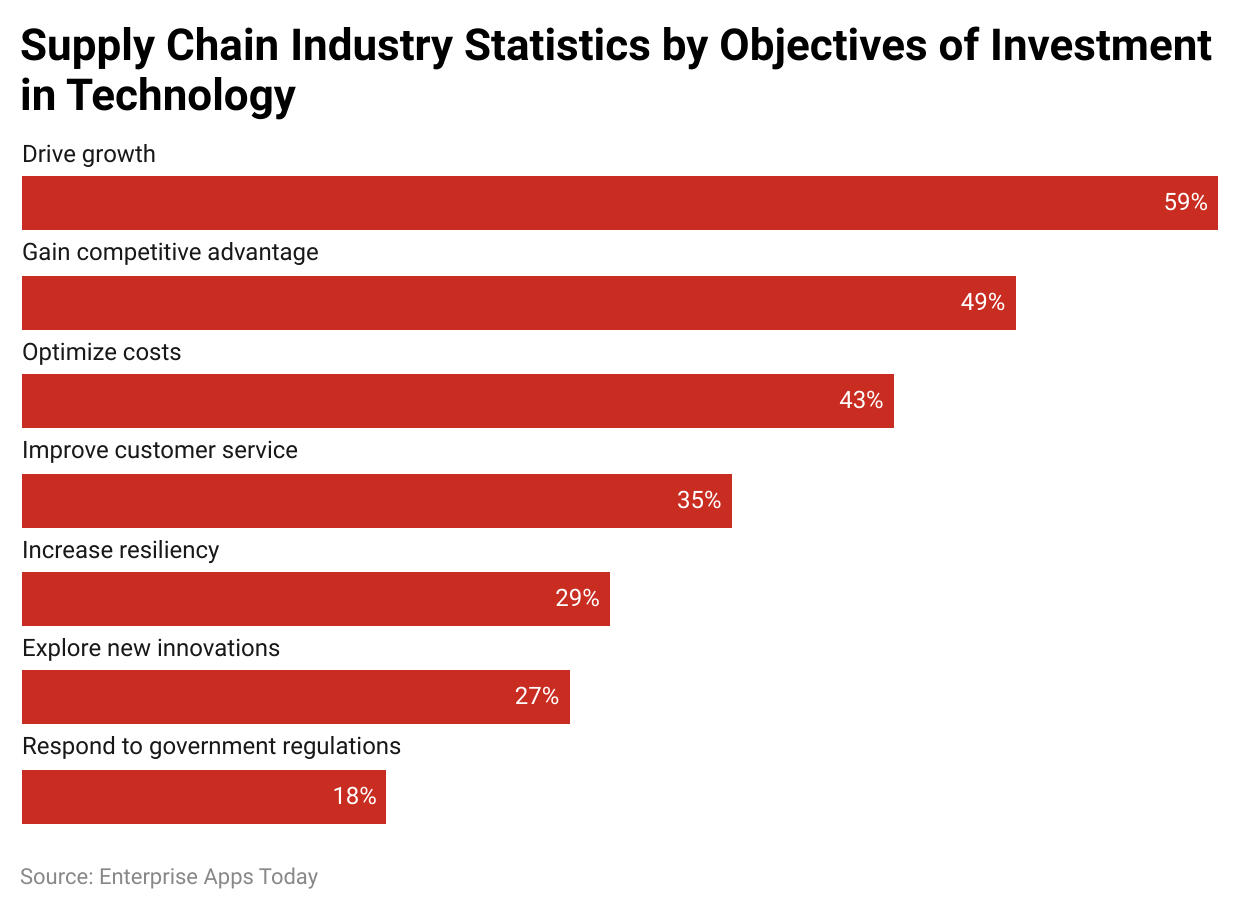 (Reference: pwc.com)
(Reference: pwc.com)
Supply Chain Industry Statistics studied by PWC survey 2023 states that, the majority of the reasons to invest in supply chain technology are to drive growth resulting in 59%, followed by gaining a competitive advantage (49%) and reducing costs (43%). Respondents to the survey stated other reasons such as improving customer service, and resiliency, exploring innovations, and as a response to the government regulations they have invested in supply chain technology.
By Challenges Faced for Digitizing Supply Chain
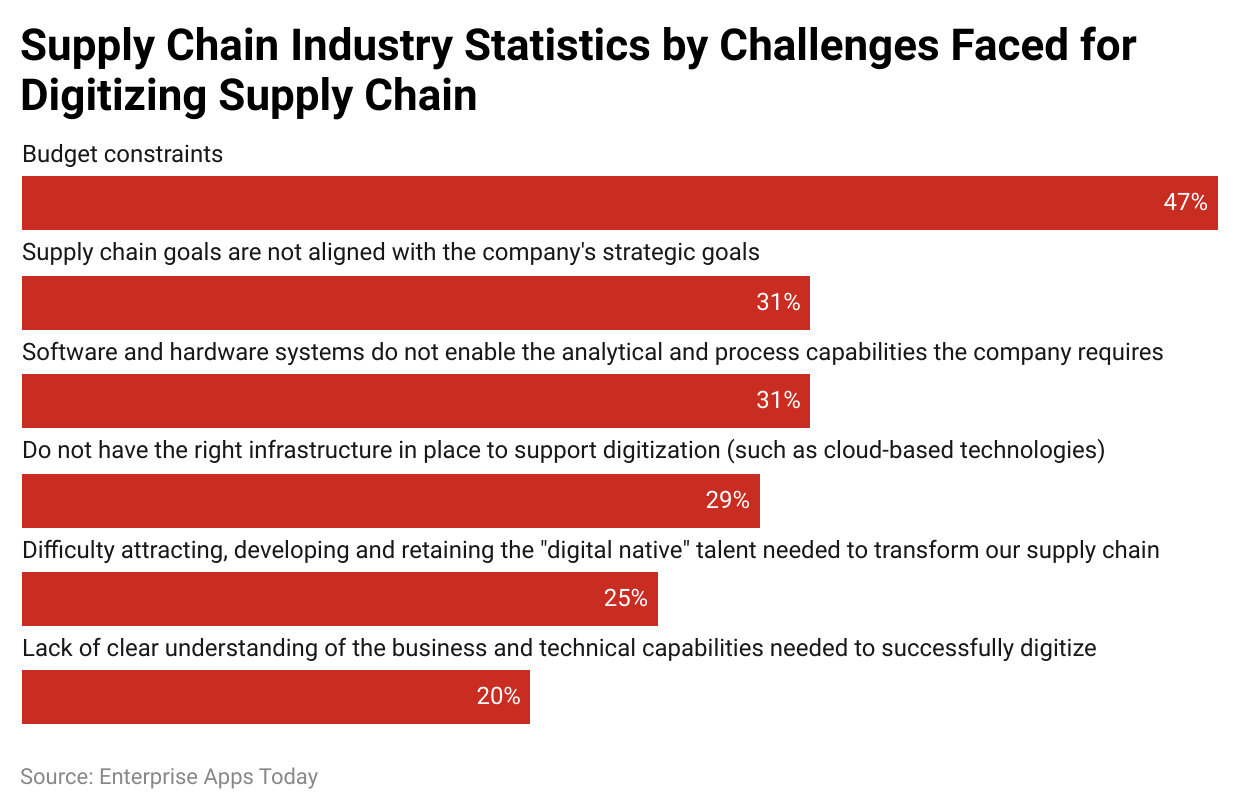 (Reference: pwc.com)
(Reference: pwc.com)
As of 2023, the top 3 challenges faced by companies in digitizing supply chains are budget constraints (47%), differences in supply chain goals and the company’s strategic goals (31%), and limitations on software and hardware systems as per the company requirements (31%). Looking at the current digitalization awareness, only 20% of survey respondents to PWC reports 2023 stated there is a lack of understanding of successful digitalization.
Conclusion
Overcoming the COVID-19 challenges, Supply Chain Industry Statistics proved that the industry is growing year on year. However, it is more likely to be affected by geopolitics as well as technological developments that could lead to differences in supply and demand as well as the replacement of human resources by automation in the coming year. With an increasing focus on automation and outsourcing, it is predicted that the supply chain industry will strengthen all over the globe irrespective of any economic or political factors. With current war-like and natural calamities like situations around the globe, the industry is still growing with the help of technology.
Sources

Joseph D'Souza started Coolest Gadgets in 2005 to share his love for tech gadgets. It has since become a popular tech blog, famous for detailed gadget's reviews and companies statistics. Joseph is committed to providing clear, well-researched content, making tech easy to understand for everyone. Coolest Gadgets is a trusted source for tech news, loved by both tech fans and beginners.











